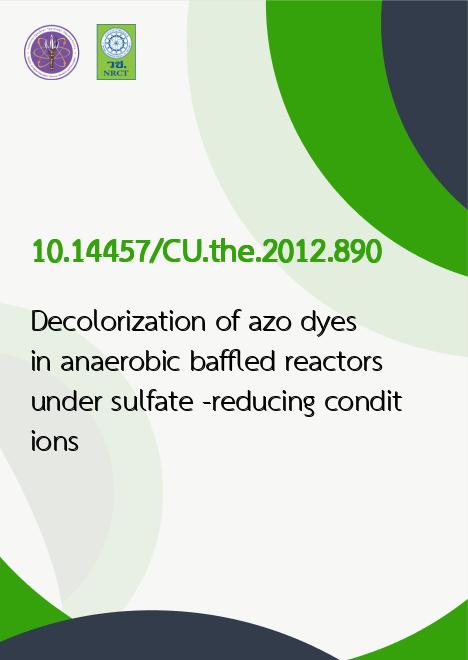
|
Decolorization of azo dyes in anaerobic baffled reactors under sulfate -reducing conditions |
|---|---|
| รหัสดีโอไอ | |
| Title | Decolorization of azo dyes in anaerobic baffled reactors under sulfate -reducing conditions |
| Creator | Chalathip Juntalasiri |
| Contributor | Benjaporn Suwannasilp |
| Publisher | Chulalongkorn University |
| Publication Year | 2555 |
| Keyword | Dyes and dying, Sewage -- Purification -- Color removal, สีย้อมและการย้อมสี, น้ำเสีย -- การบำบัด -- การกำจัดสี |
| Abstract | This study investigates the decolorization of two mono-azo dyes in two four compartment anaerobic baffled reactors (ABRs) under sulfate-reducing conditions. The azo dyes, 200 mg/L of C.I. Acid Red 18 and 80 mg/L of C.I. Acid Orange 7 were added to the synthetic wastewaters for Reactor A and Reactor B, respectively. Lactic acid and sulfate with the COD:sulfate ratio of ~0.6 were used to stimulate the growth of sulfate-reducing bacteria in the reactors. Sulfate was the main electron acceptor in both reactors and sulfate-reducing conditions were successfully developed. During day 35th until day 49th after the start-up period but before the azo dye addition, the COD removal efficiency in both reactors were rather close in which 78.6 ± 3.4 % and 82.3 ± 3.1 % of COD removal efficiency were achieved for the Reactor A and Reactor B, respectively. However, after the azo dye addition, the COD removal efficiencies in both reactors decreased to 60.1 ± 3.3 % for Reactor A and 63.1 ± 4.7 % for Reactor B. For these two reactors, most of COD removal occurred in the first compartments both before and after the addition of the azo dyes. The results show that both C.I. Acid Red 18 and C.I. Acid Orange 7 were decolorized effectively in the ABRs under sulfate-reducing conditions with the decolorization efficiencies of 97.8 ± 1.4 % and 98.3 ± 1.7%, respectively. In both reactors, azo dye decolorization occurred in all of the compartments but it occurred to the greatest extents in the first compartments. Adsorption of the azo dyes, C.I. Acid Red 18 and C.I. Acid Orange 7, by inactive biomass from both reactors was negligible. The 16S rDNA clone library results show that sulfate-reducing bacteria and fermentative bacteria were present in Reactor B. Nevertheless, the actual roles of these two groups of microorganisms on azo dye decolorization in anaerobic baffled reactors are still unclear. |
| URL Website | cuir.car.chula.ac.th |